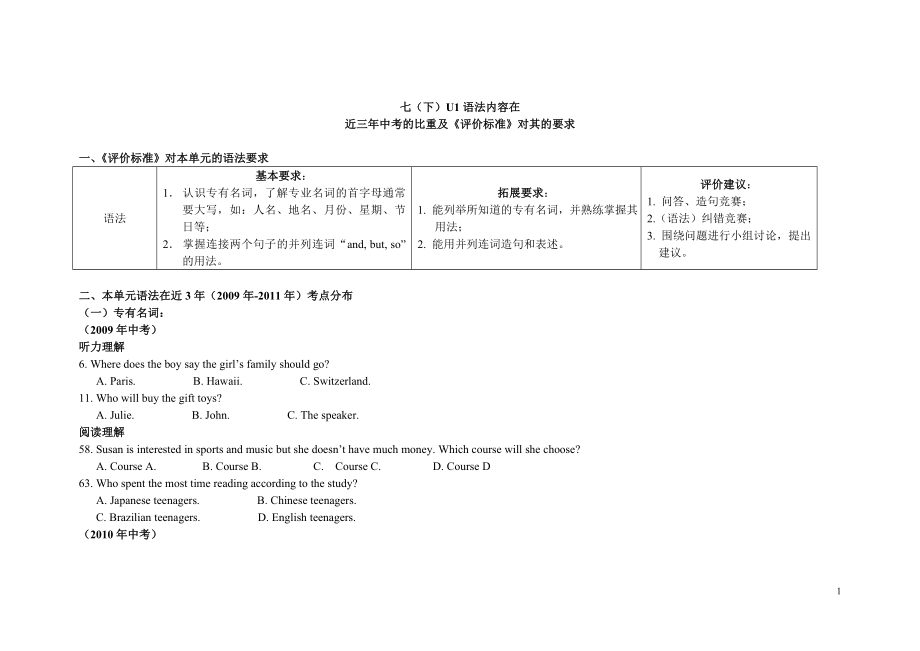《七(下)U1語(yǔ)法內(nèi)容在近年中考的比重及《評(píng)價(jià)標(biāo)準(zhǔn)》對(duì)其的要求》由會(huì)員分享�����,可在線閱讀,更多相關(guān)《七(下)U1語(yǔ)法內(nèi)容在近年中考的比重及《評(píng)價(jià)標(biāo)準(zhǔn)》對(duì)其的要求(4頁(yè)珍藏版)》請(qǐng)?jiān)谘b配圖網(wǎng)上搜索��。
1���、
七(下)U1語(yǔ)法內(nèi)容在
近三年中考的比重及《評(píng)價(jià)標(biāo)準(zhǔn)》對(duì)其的要求
一��、《評(píng)價(jià)標(biāo)準(zhǔn)》對(duì)本單元的語(yǔ)法要求
語(yǔ)法
基本要求:
1. 認(rèn)識(shí)專有名詞�,了解專業(yè)名詞的首字母通常要大寫�����,如:人名�、地名、月份��、星期���、節(jié)日等��;
2. 掌握連接兩個(gè)句子的并列連詞“and, but, so”的用法����。
拓展要求:
1. 能列舉所知道的專有名詞�,并熟練掌握其用法����;
2. 能用并列連詞造句和表述��。
評(píng)價(jià)建議:
1. 問答��、造句競(jìng)賽��;
2.(語(yǔ)法)糾錯(cuò)競(jìng)賽���;
3. 圍繞問題進(jìn)行小組討論,提出建議�。
二、本單元語(yǔ)法在近3年(2009年-2011年)考點(diǎn)分布
(一)專有名詞:
(20
2��、09年中考)
聽力理解
6. Where does the boy say the girl’s family should go?
A. Paris. B. Hawaii. C. Switzerland.
11. Who will buy the gift toys?
A. Julie. B. John. C. The speaker.
閱讀理解
58. Susan is interested in sports and music but she doesn’t have much money
3�����、. Which course will she choose?
A. Course A. B. Course B. C. Course C. D. Course D
63. Who spent the most time reading according to the study?
A. Japanese teenagers. B. Chinese teenagers.
C. Brazilian teenagers. D. English teenagers.
(2010年中考)
聽力理解
4�、
1. Where does the talk take place?
A. At a radio station. B. At a concert. C. At the Music Club.
閱讀理解
59. Where does Berners-Lee live today?
A. England. B. Switzerland. C. America. D. Canada.
62. When did the writer return to the store to talk about her
5、problem?
A. Morning of March 27. B. Afternoon of March 27.
C. Morning of March 28. D. Afternoon of March 28.
(2011年中考)
聽力理解
9. Where will the woman probably go?
A. Thailand. B. New Zealand. C. Australia
閱讀理解
61. Who invented the sport of badminto
6����、n?
A. Indians. B. British. C. Chinese. D. Koreans.
(二)連詞and, but, so
(2009年中考)
語(yǔ)法選擇
35. 文中的句子是: 35 people feel unhappy, they are more careful with a problem or difficult situation.
A. So B. But C. When D. Though
(201
7���、0年中考)
語(yǔ)法選擇
30. 文中的句子是:I soon found the key he gave me could unlock neither the front door 30 the back door!
A. and B. but C. or D. nor
(2011年中考)
單項(xiàng)選擇
17. ________ they are very tired, they feel happy because they’ve finally finished their project.
A. So
8、 B. Although C. If D. But
三���、本單元語(yǔ)法連詞and, but, so在近3年(2009年-2011年)考點(diǎn)數(shù)量和分析
年份
直接考察
間接考察
考察題型及題量
2009
0
4
聽力理解2題���,閱讀理解2題
2010
0
3
聽力理解1題,閱讀理解2題
2011
0
2
聽力理解1題���,閱讀理解1題
本單元語(yǔ)法連詞and, but, so在近3年(2009年-2011年)考點(diǎn)數(shù)量和分析
年份
直接考察
間接考察
考察題型及題量
2009
0
1
語(yǔ)法選擇1題
2010
0
9�����、
1
語(yǔ)法選擇1題
2011
0
1
單項(xiàng)選擇1題
小結(jié):在近3年中考中有關(guān)“專有名詞”的考題�����,主要是出現(xiàn)在聽力和閱讀文段���,只要求學(xué)生能看懂就行了。而連詞and, but, so則都是以間接考察的方式出現(xiàn)��,沒有直接作為直接考察的內(nèi)容����??疾祛}型主要集中在語(yǔ)法選擇和單項(xiàng)選擇����。
以上數(shù)據(jù),僅供參考���,如有疏漏之處��,請(qǐng)多包涵指正!
(2010年中考)
單項(xiàng)選擇
22. It doesn’t look like rain, so you ________ bring your umbrella with you.
A. shouldn’t B. mus
10���、tn’t C. can’t D. needn’t
(2011年中考)
單項(xiàng)選擇
21.– Excuse me, can I smoke here?
-- No, ________.
A. you must B. you’d not better
C. you can D. you’d better not
三�����、本單元語(yǔ)法在近3年(2009年-2011年)考點(diǎn)數(shù)量和分析
年份
直接考察
間接考察
考察題型及題量
2009
1
0
單項(xiàng)選擇1題
2010
1
0
單項(xiàng)選擇1題
2011
0
1
單項(xiàng)選擇1題
小結(jié):在近3年中考中有關(guān)“情態(tài)動(dòng)詞can, could, may, might, must, need”的考題�,集中出現(xiàn)在單項(xiàng)選擇�,以間接考察或直接考查的方式出現(xiàn),并都以考查否定形式為主�。
以上數(shù)據(jù),僅供參考��。如有疏漏之處,請(qǐng)多包涵指正��!
4
 七(下)U1語(yǔ)法內(nèi)容在近年中考的比重及《評(píng)價(jià)標(biāo)準(zhǔn)》對(duì)其的要求
七(下)U1語(yǔ)法內(nèi)容在近年中考的比重及《評(píng)價(jià)標(biāo)準(zhǔn)》對(duì)其的要求

